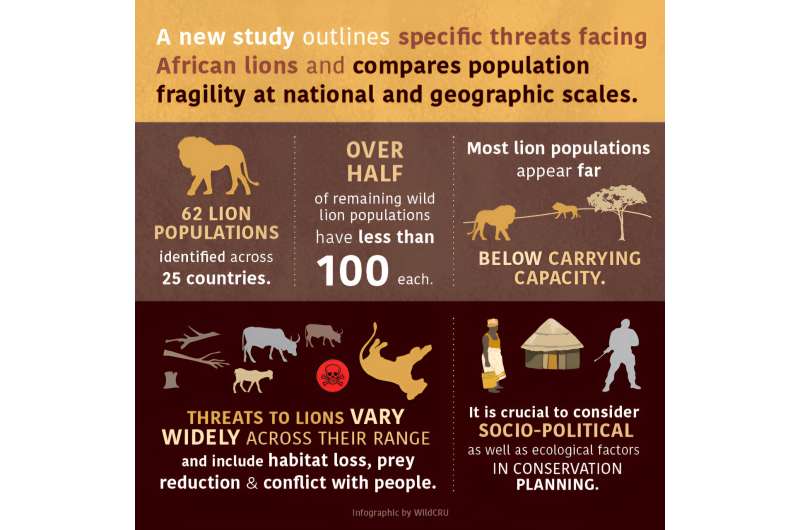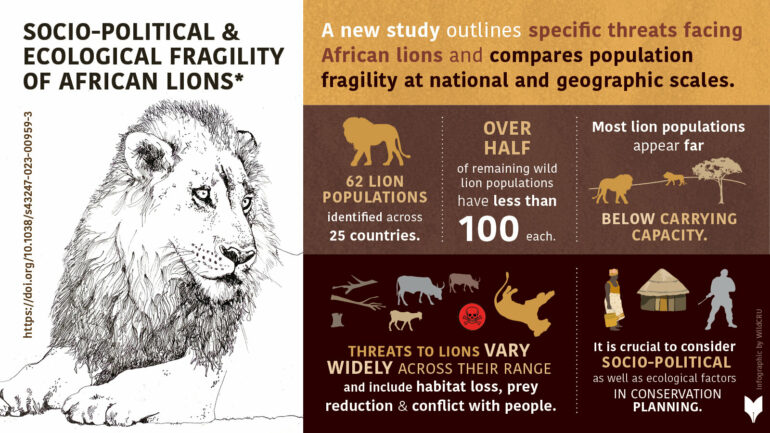New research published in the journal Communications Earth & Environment, reveals alarming data about dwindling lion populations in Africa but gives new insight into conservation strategies.
The research, led by Professor Amy Dickman of the Wildlife Conservation Research Unit (WildCRU) at the University of Oxford and Sam Nicholson of the Endangered Wildlife Trust, along with 32 additional co-authors from around the world, provides a framework for evaluating investments into saving lions across Africa.
Professor Dickman said, “Lions are one of the most iconic species in the world, but are undergoing devastating declines. This comprehensive analysis is the first to look at both ecological and socio-political risk factors facing lions at scale. Conservation science is important to guide action, but this research highlights the invaluable role that politicians, economists, development experts and others must play if we are to safeguard lions and other biodiversity.”
The research findings clearly demonstrate that, even when they are the same size, lion populations may have significant differences in their vulnerability due to ecological and socio-political risk factors.
“For instance,” explains senior author Dr. Andrew Jacobson of Catawba College in North Carolina, U.S., “both Sudan and Benin have a single known lion population each, that have approximately the same number of lions. However, Benin’s lone population is part of a much larger transfrontier conservation area shared with two other countries, and Benin is a relatively more stable and prosperous country than Sudan.”
“Sudan’s lone population is also contiguous with a lion population in another country (Ethiopia in this case); however, the country is involved in a civil war with people fleeing in the millions. The war and instability undercuts the ability of park rangers or others to help ensure the continuation of Sudan’s lions. This comparison demonstrates how when evaluating investments into protecting lions, both ecological and socio-political factors must be considered.”
The study first identified and mapped wild African lion populations, building on extensive lion monitoring which WildCRU projects have played a major role in for decades. The researchers then created two general categories of population fragility, being ecological and socio-political, and identified factors in these two categories that may influence the survival of wild lions.
For example, a smaller lion population or higher densities of people and livestock were factors contributing to higher ecological fragility, while higher levels of corruption or lower GDP per capita would contribute to greater socio-political fragility.
The socio-political and ecological factors were combined into a single overall fragility index, and each lion population was compared relative to all others. The fragility score does not suggest which lion populations deserve protection or funding. It does, however, highlight the varying ecological and anthropogenic pressures facing different populations and which populations may require relatively more resources (financial or other) to conserve.

Summary of research findings, Nicholson, Samantha K., et al. 2023. © Sarah Markes, WildCRU.
The combination of these two indices provided some interesting comparisons. Professor Amy Dickman added, “Some populations may ultimately have similar fragility scores, but they are driven by different threats. Thus, while on the surface, the lone lion populations in Sudan and Benin may appear similar, they likely require different levels of investment and perhaps even different types of intervention for conservation to succeed.”
“Pouring money into conserving Sudan’s lions may be relatively ineffective unless the socio-political factors such as the civil war are dealt with first. Thus, stakeholders, investors and conservation groups must be aware of these differences when approaching lion conservation and evaluating how much money, time or other investment may be needed to see success.”
Co-lead author Sam Nicholson of the Endangered Wildlife Trust, said, “This research is the first of its kind in bringing together both ecological and socio-political factors into a single index to evaluate potential conservation investments for African lions. This is critical because the challenges faced by lions have both ecological and socio-political roots.”
Indeed, lion conservation is needed more than ever. Less than half of the 62 known remaining free-ranging wild African lion populations house over 100 lions. African lions remain in only 25 countries and nearly half of these nations have fewer than 250 individuals. Eight countries now house only a single wild lion population. Although the total African population may be estimated at between 20,000 and 25,000 individuals, there is concern that these small, fragmented populations and countries with few individuals will disappear.
Rapidly growing anthropogenic pressures on natural resources, particularly in Africa, suggest a challenging future for lions, and wildlife in general. With human-induced threats like habitat loss, prey depletion, and human-wildlife conflict, lions are increasingly being pushed to the brink.
However, substantial efforts are being made to halt population loss and regain territory. Conservation efforts are having some success, such as expanding lion populations in Niokolo Koba National Park, Senegal, and Gorongosa National Park in Mozambique.
Notably, almost all of remaining African lion range is within countries that rank in the 25% poorest countries in the world. While lions have been eliminated from many countries in sub-Saharan Africa, North Africa and the Middle East, the countries that eliminated their lions a century or more ago, are largely those with relatively less poverty today. This leaves the remaining African lions vulnerable to the pressures felt by many of the poorest countries and communities in the world.
Previous estimates suggest more than US$1 billion may be needed annually to maintain the existing lion populations within protected areas, however the researchers estimate that the costs for protecting all the remaining African lions is closer to US$3 billion annually.
This research underscores the moral responsibility of wealthier nations to contribute more significantly to lion conservation and helps to identify some of the factors which need to be considered to make that contribution more effective.
More information:
Samantha K. Nicholson et al, Socio-political and ecological fragility of threatened, free-ranging African lion populations, Communications Earth & Environment (2023). DOI: 10.1038/s43247-023-00959-3
Provided by
University of Oxford
Citation:
New analysis reveals the differing threats to African lion populations (2023, September 11)
